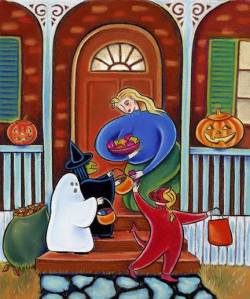DIANA'S DESSERTS NEWSLETTEREDITION NUMBER 23 October 10, 2004 Welcome Home Bakers and Friends, In this first full month of autumn, some of us will celebrate a "spooky and fun" Halloween. Muslims will experience the Holy month of Ramadan, a 30-day period culminating with the festival, Eid- ul-Fitar, or Feast of the Fast-breaking, and here in the United States we observe Columbus Day (celebrating Christopher Columbus' discovery of America in 1492). A lot going on this month with people from all over the world celebrating holidays of their specific countries or religions and that means more opportunities to make some sweet and tasty treats. In this edition of Diana's Desserts Newsletter, I will be focusing on recipes for Halloween "Treats", sharing some healthy food information for those of you who are Muslim who celebrate Ramadan, and including a scrumptious Tiramisu recipe for Columbus Day. The Food Tips and Information section this month is about Pumpkins. See the article below and a great recipe for Pumpkin Praline Cheesecake, one of my favorites. A guest submitted recipe is always included in Diana's Desserts Newsletter, and for October, the recipe is for a very delicious Southern Pecan Praline Pound Cake submitted by Nanny Judy. As always, I hope you enjoy all of the recipes, and that the information on Pumpkins is helpful and informative. Guest Submitted Recipe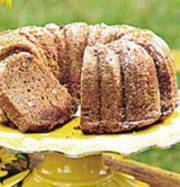
Southern Pecan Praline Pound CakeServings: 10-12Comments: This is a fast, easy and delicious cake. Its very moist and keeps well. I hope you all will like it. The ready-made Coconut Pecan Frosting is added to the batter which makes the cake very moist and rich. Ingredients: 1 (18.25-ounce) package German Chocolate cake mix 1 can Coconut Pecan frosting 1 cup water 3 large eggs 1/3 cup canola or vegetable oil 3/4 cup chopped pecans 1/2 cup shredded coconut Instructions: Preheat oven to 350 degrees F (180 C). Spray a 9 or 10-inch bundt pan with nonstick cooking spray. Put all ingredients (yes, including the coconut pecan frosting) in a large mixing bowl and beat with an electric mixer for 2 minutes. Pour mixture into prepared bundt pan and bake for 50 minutes in preheated 350 degree F (180 C) oven. Cool cake in pan for 20 minutes (I put it on a bottle, like a ketchup or wine bottle to cool). Transfer cake to a cooling rack to cool completely. The pound cake can be served plain or with a pecan praline sauce (recipe to follow). Makes 10-12 servings. Pecan Praline Sauce Ingredients: 6 Tbsp. butter 1 cup brown sugar 4 Tbsp. heavy cream or half & half 1 cup pecans pieces Instructions: In a medium saucepan heat butter, sugar and cream until it boils. Remove from heat and add pecans. Pour warm sauce over cake before serving. Source: Friend Submitted By: Nanny Judy Date: September 8, 2004 Click here to view recipe and photo of Southern Pecan Praline Pound Cake on Diana's Desserts Website 
Columbus DayCelebrated on Monday October 11, 2004Columbus Day is an American holiday, commemorating the date of Christopher Columbus's arrival in the New World in 1492. It was first celebrated by Italians in San Francisco in 1869, following on the heels of celebrations in New York City. The first state celebration was in Colorado in 1905, and in 1937, President Franklin Delano Roosevelt set aside Columbus Day as a holiday in the United States. Since 1971, the holiday has been commemorated in the U.S. on the second Monday in October, the same day as Thanksgiving in neighboring Canada. Americans might not have a Columbus Day if Christopher Columbus had not been born in Italy. Out of pride for their native son, the Italian population of New York City organized the first celebration of the discovery of America on October 12, 1866. The next year, more Italian Organizations in other cities held banquets, parades and dances on that date. In 1869, when Italians of San Francisco celebrated October 12, they called it Columbus Day. Although it is generally accepted that Christopher Columbus was the first European to have discovered the New World of the Americas, there is still some controversy over this claim. Some researchers and proponents of other explorers attribute the first sightings to the early Scandinavian Vikings or the voyages of Irish missionaries which predate the Columbus visit in 1492. The controversy may never be fully resolved to everyone's satisfaction, but 1992 marked the 500th anniversary of the Columbus discovery. An Italian Recipe for Columbus Day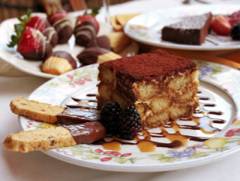
TiramisuServings: 10-12Comments: Definition for Tiramisu: [tih-ruh-mee-SOO; tih-ruh-MEE-soo] The translation for tiramisu is "carry me up", and many who taste this ethereal dessert assume the unspoken continuation must surely be "to heaven." Tiramisu is a light composition of sponge cake or ladyfingers dipped in a coffee-marsala mixture, then layered with mascarpone (an ultra-rich Italian cream cheese) and topped with cocoa powder or grated chocolate. The dessert is refrigerated for several hours before serving to allow the flavors to intermingle. Although tiramisu is sometimes referred to as an Italian trifle, its texture is much lighter than that dessert. Make this "to die for" Italian dessert for Columbus Day and enjoy with a strong cup of coffee or espresso! Ingredients: 3/4 cup confectioners' sugar 3 cups whipping cream 2 (8 oz.) containers mascarpone cheese (16 oz. total) 1 tablespoon vanilla extract pinch of salt 1 1/2 packages ladyfingers 1/3 cup cold strong coffee or espresso 1/3 cup marsala wine, brandy, amaretto or white rum Cocoa powder, or grated chocolate Instructions: In a large bowl, lightly beat the mascarpone to smooth it out. Add the confectioners' sugar, cream, vanilla, and salt and using an electric beater, beat this mixture until it is smooth and thickened like fluffy cream. Using a 9 x 13-inch pan, or a medium size glass oval baking dish, line the bottom with ladyfingers, flat side down. Combine the cold, strong coffee (use 2 tablespoons instant espresso powder to 1/3 cup of cold water) and the liquor in a cup. Using a pastry brush, lightly brush half of the coffee/liquor mixture over the ladyfingers. Cover with half of the mascarpone mixture. Sprinkle liberally with powdered cocoa. Add another layer of ladyfingers, and repeat as above. Sprinkle top liberally with the cocoa. Cover tightly with plastic wrap and refrigerate at least 24 hours. This is important, as it blends the flavors and the ladyfingers soak up the liquid. A perfect tiramisu should slice easily, but can be a little soft and perhaps even a little runny when served, rather than holding its shape perfectly. Makes 10-12 servings. Click here to view recipe and photo of Tiramisu on Diana's Desserts Website 
RamadanAccording to the Islamic Society of North America the first day of fasting for Ramadan 2004 is expected to be October 16th.What is Ramadan? Ramadan is the ninth month of the Muslim calendar. It is during this month that Muslims observe the Fast of Ramadan. Lasting for the entire month, Muslims fast during the daylight hours and in the evening eat small meals and visit with friends and family. It is a time of worship and contemplation. A time to strengthen family and community ties. The Fast of Ramadan The Month of Ramadan is also when it is believed the Holy Quran "was sent down from heaven, a guidance unto men, a declaration of direction, and a means of Salvation" It is during this month that Muslims fast. It is called the Fast of Ramadan and lasts the entire month. Ramadan is a time when Muslims concentrate on their faith and spend less time on the concerns of their everyday lives. It is a time of worship and contemplation During the Fast of Ramadan strict restraints are placed on the daily lives of Muslims. They are not allowed to eat or drink during the daylight hours. Smoking and sexual relations are also forbidden during fasting. At the end of the day the fast is broken with prayer and a meal called the iftar. In the evening following the iftar it is customary for Muslims to go out visiting family and friends. The fast is resumed the next morning According to the Holy Quran: One may eat and drink at any time during the night "until you can plainly distinguish a white thread from a black thread by the daylight: then keep the fast until night" The good that is acquired through the fast can be destroyed by five things: 1. The telling of a lie 2. Slander 3. Denouncing someone behind his back 4. A false oath 5. Greed or covetousness These are considered offensive at all times, but are most offensive during the Fast of Ramadan. During Ramadan, it is common for Muslims to go to the Masjid (Mosque) and spend several hours praying and studying the Quran. In addition to the five daily prayers, during Ramadan Muslims recite a special prayer called the Taraweeh prayer (Night Prayer). The length of this prayer is usually 2-3 times as long as the daily prayers. Some Muslims spend the entire night in prayer. On the evening of the 27th day of the month, Muslims celebrate the Laylat-al-Qadr (the Night of Power). It is believed that on this night Muhammad first received the revelation of the Holy Quran. And according to the Quran, this is when God determines the course of the world for the following year. When the fast ends (the first day of the month of Shawwal) it is celebrated for three days in a holiday called Eid-al-Fitar (the Feast of Fast Breaking). Gifts are exchanged. Friends and family gather to pray in congregation and for large meals. In some cities fairs are held to celebrate the end of the Fast of Ramadan. IftarThe food eaten immediately after sunset to break fast. Here are some healthy foods to eat during the Iftar.Dates, three Juice, 1 serving (4 oz.) Vegetable soup with some pasta or graham crackers, 1 cup The body's immediate need at the time of iftar is to get an easily available energy source in the form of glucose for every living cell, particularly the brain and nerve cells. Dates and juices are good sources of sugars. Dates and juice in the above quantity are sufficient to bring low blood glucose levels to normal levels. Juice and soup help maintain water and mineral balance in the body. An unbalanced diet and too many servings of sherbets and sweets with added sugar have been found to be unhealthy. Sahur(pre-dawn meal)First of all, there is no need to consume excess food at dinner or sahur (the light meal generally eaten about half an hour to one hour before dawn). The body has regulatory mechanisms that activate during fasting. There is efficient utilization of body fat. Basal metabolism slows down during Ramadan fasting. A diet that is less than a normal amount of food intake but balanced is sufficient enough to keep a person healthy and active during the month of Ramadan. Here are some healthy foods to eat during Sahur. Consume a light sahur. Eat whole wheat or oat cereal or whole wheat bread, 1-2 servings with a cup of milk. Add 2-3 teaspoons of olive oil or any other monounsaturated or polyunsaturated fats in a salad or the cereal. Eat 1-2 servings of fruits, as a last item. Dinner Meal: Consume foods from all the following food groups: Meat/Bean Group: Chicken, beef, lamb, goat, fish, 1-2 servings (serving size = a slice =1 oz); green pea, chickpea (garbanzo, chana, humus), green gram, black gram, lentil, lima bean and other beans, 1 serving (half cup). Meat and beans are a good source of protein, minerals, and certain vitamins. Beans are a good source of dietary fiber, as well. Bread/Cereal Group: Whole wheat bread, 2 servings (serving size = 1 oz) or cooked rice, one cup or combination. This group is a good source of complex carbohydrates, which are a good source of energy and provide some protein, minerals, and dietary fiber. Milk Group: Milk or buttermilk (lassi without sugar), yogurt or cottage cheese (one cup). Those who can not tolerate whole milk must try fermented products such as buttermilk and yogurt. Milk and dairy products are good sources of protein and calcium, which are essential for body tissue maintenance and several physiological functions. Vegetable Group: Mixed vegetable salad, 1 serving (one cup), (lettuce, carrot, parsley, cucumber, broccoli, coriander leaves, cauliflower or other vegetables as desired.) Add 2 teaspoons of olive oil or any polyunsaturated oil and 2 spoons of vinegar. Polyunsaturated fat provides the body with essential fatty acids and keto acids. Cooked vegetables such as guar beans, French beans, okra (bhindi), eggplant (baigan), bottle gourd (loki), cabbage, spinach, 1 serving (4 oz). Vegetables are a good source of dietary fiber, vitamin A, carotene, lycopenes, and other phytochemicals, which are antioxidants. These are helpful in the prevention of cancer, cardiovascular diseases, and many other health problems. Fruits Group: 1-2 servings of citrus and/or other fruits. Eat fruits as the last item of the dinner or soon after dinner, to facilitate digestion and prevent many gastrointestinal problems. Citrus fruits provide vitamin C. Fruits are a good source of dietary fiber. Fruits and mixed nuts may be eaten as a snack after dinner or tarawiaha or before sleep. Further Suggestions: Drink sufficient water between Iftar and sleep to avoid dehydration. Consume sufficient vegetables at meals. Eat fruits at the end of the meal but remember to wait for a while before so as not disturb the food processing in your stomach i.e. fermentation, bloating etc.. Avoid intake of high sugar (table sugar, sucrose) foods through sweets or other forms. Avoid spicy foods. Avoid caffeine drinks such as coke, coffee or tea. Caffeine is a diuretic. Three days to five days before Ramadan gradually reduce the intake of these drinks. A sudden decrease in caffeine prompts headaches, mood swings and irritability. Smoking is a health risk factor. Avoid smoking cigarettes. If you cannot give up smoking, cut down gradually starting a few weeks before Ramadan. Smoking negatively affects utilization of various vitamins, metabolites and enzyme systems in the body. Do not forget to brush your teeth before sleep and after Sahur. Brush more than two times or as many times as practical. Normal or overweight people should not gain weight. For overweight people Ramadan is an excellent opportunity to lose weight. Underweight or marginally normal weight people are discouraged from losing weight. Analyzing a diet's energy and nutritional component, using food composition tables or computer software, will be useful in planning an appropriate diet. It is recommended that everyone engage in some kind of light exercise, such as stretching or walking. It's important to follow good time management practices for Ibada (prayer and other religious activities), sleep, studies, job, and physical activities or exercise. Sick people, travelers, and women in certain conditions are exempted from the fast but must make it up as they are able. Perhaps fasting in Ramadan is the most widely practiced of all the Muslim forms of worship. In summary, intake of a balanced diet is critical to maintain good health, sustain an active lifestyle and attain the full benefits of Ramadan. Source: Islamic-World.net - http://islamic-world.net/sister/h22.htm Celebrating Eid-ul-FitarEid-ul-Fitar is a time to rejoice and celebrate the end of the Ramadan. Eid is celebrated with much enthusiasm and fervor and Muslims from all strata of life can be seen adorned in beautiful new clothes, visiting the mosques to attend Eid prayers. Greetings of "Eid-Mubarak" or "a blessed Eid" are exchanged. While mostly women at home, are all dressed up in new clothes with chorian and henna decorated on their hands, set up the table with the traditional Eid dishes. The celebration continues for three days. While making special food for Eid should be given priority this week, people should not forget that part of the pleasure is in the presentation. In other words, food served in the usual plates and dishes, on the usual bland kitchen or dinner table is simply not good enough for the Eid lunch or dinner. Decorating the table and "dressing up" the food will give more of the Eid feeling to your meal. Here are some tips that can help:1. Call a family meeting: Make it a family effort instead of doing everything by yourself. This is so you can set a time where everyone is present to have a meal together. This can be lunch or dinner time. The meeting is also a time to decide who does what for the meal. 2. Cleanliness: Fancy decorations are great, but they lose their appeal if the surrounding area and the table are not clean. The kitchen and dining room are two areas that should be extra clean and virtually spotless for Eid, along with the rest of the house. This should be the first priority. 3. Menu: Get the whole family to decide on a menu. There needs to be, of course, a main dish, side dishes, snacks and dessert. Appetizers can be fit in as well if everyone wants them. The aim should be to make foods which are not normally eaten during the regular meals. There should also be a variety and dishes should be balanced between what different people like, so that there are dishes for everyone's taste. Try to have some dishes which are not necessarily from your specific cultural background. For instance, if you're from an Indo-Pakistani background, why not try making Tumr Bel Nargine as a sweet appetizer or dessert? Or if you are of an Arabic background why not make Ras Malai or Gajer ka Halwa. Recipe for Eid-ul-Fitar (ending of Ramadan)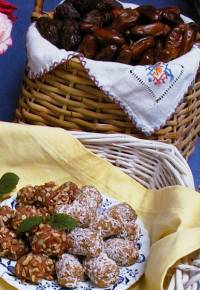
Coconut Dates (Tumr Bel Nargine)Serves 8-10Comments: Coconut dates, a Saudi Arabian specialty, but eaten in other middle eastern countries and in asia, are a sweet and healthy appetizer or dessert to serve for Eid-ul-Fitar, the ending of the Muslim Fast of Ramadan. Ingredients: 3/4 pound blanched almonds 1 1/2 pounds soft pitted dates 1 tsp. ground cardamom 2 cups desiccated or flaked coconut 1/2 cup (1 stick/4 oz/113g) butter Instructions: 1. Fry the almonds in little until golden brown, then place them on absorbent paper towels for a few minutes to absorb any excess oil. 2. Melt butter in a heavy sauce pan. Add dates and ground cardamom. Stir well over low heat, until well blended. (Dates should not stick to the bottom and sides of the pan.) Remove from heat and set aside to cool. 3. Wet your palm and place a small amount of date mixture in the center of your palm and shape into a smooth ball. Indent the center with your thumb and press an almond into it. Fold the sides and reshape into an oval or date shape. Repeat with remaining date mixture. 4. Roll each date in the desiccated coconut and arrange on a serving dish. Serves 8-10 Click here to view recipe and photo of Coconut Dates on Diana's Desserts Website 
HalloweenCelebrated every year on October 31stThe Story of Halloween Halloween is one of the oldest holidays with origins going back thousands of years. The holiday we know as Halloween has had many influences from many cultures over the centuries. From the Roman's Pomona Day, to the Celtic festival of Samhain, to the Christian holidays of All Saints and All Souls Days. Hundreds of years ago in what is now Great Britain and Northern France, lived the Celts. The Celts worshipped nature and had many gods, with the sun god as their favorite. It was "he" who commanded their work and their rest times, and who made the earth beautiful and the crops grow. The Celts celebrated their New Year on November 1st. It was celebrated every year with a festival and marked the end of the "season of the sun" and the beginning of "the season of darkness and cold." On October 31st after the crops were all harvested and stored for the long winter the cooking fires in the homes would be extinguished. The Druids, the Celtic priests, would meet in the hilltop in the dark oak forest (oak trees were considered sacred). The Druids would light new fires and offer sacrifices of crops and animals. As they danced around the the fires, the season of the sun passed and the season of darkness would begin. When the morning arrived the Druids would give an ember from their fires to each family who would then take them home to start new cooking fires. These fires would keep the homes warm and free from evil spirits. The November 1st festival was called Samhain (pronounced "sow-en"). The festival would last for 3 days. Many people would parade in costumes made from the skins and heads of their animals. This festival would become the first Halloween. During the first century the Romans invaded Britain. They brought with them many of their festivals and customs. One of these was the festival know as Pomona Day, named for their goddess of fruits and gardens. It was also celebrated around the 1st of November. After hundreds of years of Roman rule the customs of the Celtic's Samhain festival and the Roman Pomona Day mixed becoming 1 major fall holiday. The next influence came with the spread of the new Christian religion throughout Europe and Britain. In the year 835 AD the Roman Catholic Church would make November 1st a church holiday to honor all the saints. This day was called All Saint's Day, or Hallowmas, or All Hallows. Years later the Church would make November 2nd a holy day. It was called All Souls Day and was to honor the dead. It was celebrated with big bonfires, parades, and people dressing up as saints, angels and devils. But the spread of Christianity did not make people forget their early customs. On the eve of All Hallows, Oct. 31, people continued to celebrate the festivals of Samhain and Pomona Day. Over the years the customs from all these holidays mixed. October 31st became known as All Hallow Even, eventually All Hallow's Eve, Hallowe'en, and then - Halloween. The Halloween we celebrate today includes all of these influences, Pomona Day's apples, nuts, and harvest, the Festival of Samhain's black cats, magic, evil spirits and death, and the ghosts, skeletons and skulls from All Saint's Day and All Soul's Day. Source: Holidays on the Net - The Story of Halloween: http://www.holidays.net/halloween/story.htm Halloween Treats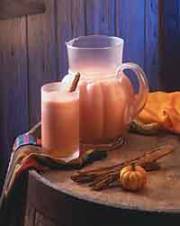
Witch's BrewMakes 4 (6 ounce) servingsComments: Grown-ups will enjoy this delicious "Witch's Brew" as much as the kids on Halloween, or for that matter, any other time. Ingredients: 2 cups apple cider 1 1/2 to 2 cups vanilla ice cream 2 tablespoons honey 1/2 teaspoon ground cinnamon 1/4 teaspoon ground nutmeg Instructions: Process cider, ice cream, honey, cinnamon and nutmeg in food processor or blender until smooth. Pour into glasses and sprinkle with additional nutmeg. Serve immediately. Serving Suggestion: Add a few drops of desired food coloring to ingredients in food processor to make a scary brew, or use Orange Sherbet instead of vanilla ice cream. Lighten Up: To reduce fat, replace vanilla ice cream with reduced-fat or fat-free ice cream or frozen yogurt. Makes 4 (6 ounce) servings. Click here to view recipe and photo of Witch's Brew on Diana's Desserts Website 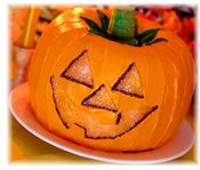
Cake O' LanternMakes 24 servingsComments: Cake O' Lantern made from two bundt cakes, this Jack O'Lantern will light up any Halloween party. Because of its delicious homemade pumpkin flavor, this cake is sure to be carved up in a hurry. If you're pressed for time, substitute three boxes of spice-cake mix for the ingredients listed here. Ingredients: For the Cake: 5 1/2 cups all-purpose flour 4 tsp. ground cinnamon 1 tsp. ground ginger 1/2 tsp. ground cloves 1/4 tsp. ground nutmeg 4 tsp. baking powder 1 1/2 tsp. baking soda 1 tsp. salt 1 1/4 cups milk, at room temperature 1 can (15 oz.) 100% pumpkin 1 tbsp. vanilla extract 1 cup (2 sticks/8oz/226g) unsalted butter or margarine, at room temperature 1/2 cup vegetable oil 2 1/4 cups granulated sugar 6 large eggs, at room temperature For Decorating and Frosting: 2 packages (8 oz. each) cream cheese, at room temperature 1 tbsp. vanilla extract Approximately 9 cups powdered sugar Green food-coloring paste Orange food-coloring paste One flat-bottomed green ice cream cone 12 large yellow and white gumdrops (6 of each) Sugar (to roll gumdrops on) 2 tbsp. chocolate chips Clear edible cake glitter Instructions: STEP 1: BAKING THE CAKE O' LANTERN Heat the oven to 350 degrees F (180 C), and butter two 10-inch bundt cake pans. In a large bowl, stir together the flour, spices, baking powder, baking soda and salt. In a medium bowl, stir together the milk, pumpkin and vanilla extract until smooth. In another large bowl, beat the butter or margarine and oil together with an electric mixer until combined. Next, beat in the sugar. Then beat in the eggs, one at a time, mixing well after each addition. Alternately beat in the milk/pumpkin mixture and the flour mixture until just combined. Divide the batter between the two prepared pans. Bake for 50 to 60 minutes or until a toothpick inserted into the center of the cakes comes out clean. Cool the cakes in the pans for 15 minutes, then turn them out onto wire racks to cool completely. STEP 2: DECORATING THE CAKE O' LANTERN In a large bowl, beat the cream cheese until smooth. Mix in the vanilla extract. Then beat in the powdered sugar gradually until the frosting is a spreadable consistency. Color about 1 cup of the frosting green and the rest orange. STEP 3: ASSEMBLING THE CAKE O' LANTERN Trim the bottoms of the cakes so they lie flat against each other. Frost the flat surface of the bottom cake and place the other cake on top. Frost the entire cake orange. When the frosting dries, add green frosting leaves and top with the ice cream cone to create a stem. Sprinkle sugar over your work surface and use a rolling pin to flatten 12 large yellow and white gumdrops together into a pancake about 1/4 inch thick. Adults only--use a knife to cut out the eyes, nose and mouth. Microwave 2 tablespoons of chocolate chips for about 60 seconds. Dip the left side and bottom of the facial features in the melted chocolate. Dab a small amount of water onto the top surface of each feature, sprinkle the edible glitter on top, then press the facial features onto the cake. Makes 24 servings. Source: Family Fun Magazine Click here to view recipe and photo of Cake O' Lantern on Diana's Desserts Website 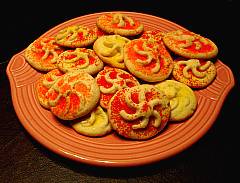
Spider Sugar CookiesMakes 2 dozen cookiesComments: These Halloween Cookies are easy and fun to make. Have your kids help with cutting them out and decorating them with sprinkles or colored decorator sugar. Make an extra batch for your children to bring to school for tasty "treats" to share with their school mates on Halloween. These cookies are very buttery and taste so good, your little goblins will be "howling" for more. Ingredients: 2 cups all-purpose flour 1/4 tsp. salt 3/4 cup granulated sugar 1 large egg 1/2 cup (1 stick/4oz/113g) unsalted butter 1 tsp. vanilla extract Sprinkles or colored decorator sugar Instructions: Preheat oven to 325 degrees F (160 C). In a large mixing bowl, combine flour and salt. In a separate bowl, combine butter and sugar, then add the egg and vanilla and beat well. Combine with the flour mixture. Roll dough into a ball, and place into plastic bag. Refrigerate for 1 hour. Roll dough into 1 to 1 1/2-inch balls on a floured surface. Use a spider design or other Halloween cookie press or stamp to shape and flatten dough balls, then place on a lightly greased cookie sheet. Decorate with sprinkles or colored sugars. Bake in preheated 325 degree F (160 C) oven for 13 to 15 minutes. Remove cookies from oven and leave in cookie sheet for 1 minute; then transfer cookies to a cooling rack. Store at room temperature in an airtight container. Makes 2 dozen cookies. Photograph taken by Diana Baker Woodall© 2003 Source: DianasDesserts.com Click here to view recipe and photo of Spider Sugar Cookies on Diana's Desserts Website 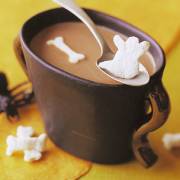
Hot Cocoa with Marshmallow SpooksServings: Makes 6 cups of hot cocoaComments: Oh so Yummy on a "Chilly Night", and so much fun for the kids, big and small. Ingredients: 6 to 8 large marshmallows 5 tbsp. Unsweetened Dutch-process cocoa 3 tbsp. granulated sugar 1/3 cup water 4 cups milk 1 cup half-and-half (half cream, half milk) Instructions: Place 1 marshmallow horizontally on a work surface. Using a rolling pin or soup can, flatten the marshmallow by rolling back and forth over it. Using Halloween-themed mini cookie cutters, cut into desired shapes. In a saucepan over medium heat, combine the cocoa, sugar and water. Bring slowly to a boil, stirring, until the sugar and cocoa dissolve, about 2 minutes. Add the milk and half-and-half and continue to cook, stirring, until bubbles appear along the edges of the pan, about 5 minutes; do not allow to boil. Pour into mugs and garnish with the marshmallow spooks. Serve immediately while the spooks hold their shapes. Makes 6 cups of hot cocoa. Click here to view recipe and photo of Hot Cocoa with Marshmallow Spooks on Diana's Desserts Website Food Tips and Information Section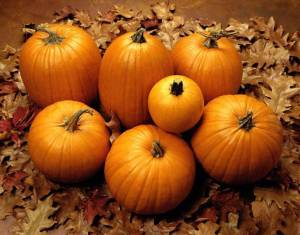
PumpkinsA winter squash, the pumpkin is a hard-shelled gourd that is related to watermelons and muskmelons. Low in calories, pumpkins are rich in fiber, potassium, riboflavin, and vitamins C and E. Mild and sweet in flavor, pumpkins offer plenty of nutritional value, and are particularly rich in carotenoid pigments such as alpha-carotene, beta carotene, and lutein. Outstanding amounts of beta carotene are found in pumpkin, with 1 cup of pumpkin providing 7.8 milligrams of this healthful pigment. Carotenoids are thought to protect against chronic diseases such as heart disease and cancer, and may also ward off age-related vision loss. Pumpkins also supply nutritious seeds and oil. Pumpkin Varieties About 99% of the pumpkins marketed domestically are used as jack-o'-lanterns at Halloween. But these deep orange pumpkins--most of which belong to a variety called Connecticut Field--are too stringy to eat, and often too large. (They can easily grow to 20 pounds, and the very largest can exceed 200 pounds.) For pie filling and other cooking needs, pie pumpkins--a smaller, sweeter variety with close-grained flesh--are much better. There are also several miniature varieties that can be eaten fresh. However, most people prefer canned pumpkin, which tastes as good as fresh (and is just as nutritious). Jack-o'-lanterns: A market term for pumpkins that are grown for their large cavities and thin walls, making them perfect for carving (but not so good for cooking). Japanese Pumpkins: Also sold as a type of winter squash called kabocha, this turban-shaped squash has a rough shell with deep green and pale green stripes. It is sweet and tastes a little like sweet potato or pumpkin. Mini Pumpkins: Available in creamy-white as well as orange, these tiny versions of the real thing serve as an ornament rather than as an edible vegetable. Pie Pumpkins: A number of pumpkins with a very high flesh-to-seed-cavity ratio are used for pies rather than for decorative purposes such as carving. One particularly flavorful pumpkin in this category is called sugar pumpkin. Availability Fresh pumpkins are available only in the fall and early winter. The sweeter varieties suitable for baking usually go straight from the fields to the canning factories. However, canned pumpkin is fine for cooking and has the advantage of being available year round. Shopping When you buy canned pumpkin, be sure to get solid-pack pumpkin puree with no added spices or sweeteners. Storage Large carving pumpkins will keep, refrigerated, for about a week. Smaller, denser pumpkins, such as kabocha or pie pumpkins, will keep for about 1 month, refrigerated. Preparation Rinse off any dirt before using. To bake a pumpkin whole, cut a lid off the top (as though you were making a jack-o'-lantern), then use a tablespoon to scrape out the seeds and strings. To bake pieces of pumpkin, halve it with a heavy chef's knife or a cleaver: Start by making a shallow cut in the skin to use as a guide to prevent the knife blade from slipping. Then place the blade in the cut and tap the base of the knife (near the handle) with your fist (or, if necessary, with a mallet or rolling pin) until the pumpkin is cut through. Scoop out the seeds and fibers and cut into smaller chunks. Serve the baked pumpkin as is, or puree it to serve as a side dish. You can also cook the puree down further to use as a pumpkin pie filling. Baking: Leave small pumpkins whole, with a lid cut out. For larger pumpkins, halve, scoop out the seeds and strings, and cut into serving-sized pieces. Place the pieces, cut-side down, in a foil-lined baking pan (its sugary juices may burn onto the pan). Pour about 1/4" of water into the pan, cover with foil, and bake in a 350° to 400° oven until tender when pierced with a knife or toothpick. Halfway through baking, the pieces may be turned, cut-side up, brushed with a little melted butter or oil, and sprinkled with brown sugar and spices. Cooking times: small whole pumpkins, 40 to 45 minutes; for cut-up pumpkin, 40 minutes. Boiling: Although this method is faster than steaming, boiling water will dilute the flavor of the pumpkin slightly. Place peeled pumpkin pieces in a small amount of boiling water and cook until tender. Drain well. Cooking times: 8 to 12 minutes. Microwaving: Place large chunks of pumpkin in a shallow microwavable dish, cover, and cook until tender. Let stand for 5 minutes after cooking. Cooking time: 8 minutes. Sautéing: Grated or peeled, diced pumpkin can be sautéed in broth, or in a combination of broth and oil. Use a nonstick skillet, if possible. Grated pumpkin is best if it is cooked just to the point where it is still slightly crunchy. Cooking time: 8 to 15 minutes. Steaming: Cook peeled chunks or slices of pumpkin in the steamer. Cooking time: 15 to 20 minutes. Source: WholeHealthMD.com: http://www.wholehealthmd.com/refshelf/foods_view/1,1523,327,00.html Recipe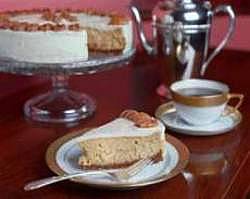
Pumpkin Praline CheesecakeServings: 12-16Ingredients: For Crust: 30 gingersnaps, broken into large chunks (about 2 heaping cups) 1/2 cup chopped pecans 1/4 cup (1/2 stick) unsalted butter 1/4 cup brown sugar For Filling: 24 ounces (3- 8oz. packages) cream cheese, softened 1/2 cup brown sugar 1/2 cup white sugar 5 large eggs 15 ounces 100% canned pumpkin 1 teaspoon ground cinnamon 1/2 teaspoon ground nutmeg 1/4 teaspoon ground ginger 1/4 teaspoon ground cloves 1 teaspoon vanilla 1 recipe White Chocolate Cream Cheese Icing (recipe follows) 1 recipe Praline Pecans (recipe follows) Instructions: Preheat oven to 300 degrees F (150 C). Place gingersnaps in bowl of food processor fitted with metal blade and pulse until coarsely ground. In a small saucepan over medium heat, sauté pecans in butter until toasted and golden brown. Add pecans and butter to food processor. Add the brown sugar to the food processor and pulse a few times to blend ingredients. Press mixture into the bottom of a 10-inch springform pan and refrigerate while preparing the filling. Place the cream cheese, brown sugar and white sugar in a large bowl and beat until smooth. Add pumpkin, spices and vanilla to bowl and mix to combine. Add eggs, one at a time, beating after each addition until incorporated. Pour into prepared crust and bake 1 hour and 30 minutes. Remove from oven and let cool at room temperature. Refrigerate overnight before serving or icing with White Chocolate Cream Cheese Icing. White Chocolate Cream Cheese Icing6 ounces good quality white chocolate, coarsely chopped8 ounces cream cheese, softened Beat cream cheese until smooth in a food processor or mixing bowl. Melt chocolate in a metal bowl over a pot of simmering water. Remove bowl from pot and wipe bottom dry. Stir with a rubber spatula until all chocolate is melted. Set aside for a few minutes to cool slightly. Beat the melted chocolate into the whipped cream cheese and spread over top and sides of the cheesecake. Praline Pecans2 tablespoons unsalted butter 2 tablespoons brown sugar 2 teaspoons cream or half and half 2 cups pecan halves Melt butter in a medium-sized skillet over medium heat. Add brown sugar and cream and bring to a boil. Add pecans, stirring well until well coated in butter mixture. Spread on a baking sheet lined with parchment paper to cool. Use to garnish Praline Pumpkin Cheesecake or toss into salads or serve with cocktails. Makes 12-16 servings. Click here to view recipe and photo of Pumpkin Praline Cheesecake on Diana's Desserts Website Until Next MonthI just want all of you to know how very important it is to me that you enjoy the recipes and articles in Diana's Desserts Newsletters and that you continue to enjoy visiting Diana's Desserts Website. Please email me with any feedback (whether positive or negative) so I will know if I am including recipes that are appealing to you as home baker's and also please let me know if you enjoy the articles. I am always interested in knowing what kinds of foods you like and also knowing what particular types of baking and kitchen tips that you might want to see here in this newsletter and on the website. Please email me at: diana@dianasdesserts.com with any of your questions or comments. I am always happy to answer you back.Next month, starting the holiday baking season off, it's Thanksgiving which is celebrated this year on Thursday November 25th. Here in America, we enjoy a long 4-day holiday weekend with lots of cooking, baking, eating, spending time with family and friends and for some of us, there's a lot of football on TV to watch. Of course, for those of us who'd rather watch a good movie, there are several of those to choose from on TV also. Many new movies are released in theaters in the United States during this long Thanksgiving holiday weekend. Thanksgiving is a time to "give thanks" for all that we have and it's also a good time to just "kick back" and relax. For some of us, it's a time to proudly show off our baking skills, so in November's newsletter, I will be focusing on recipes for this wonderful holiday. Please start submitting your delicious holiday recipes to Diana's Desserts website soon. Your recipes are usually posted with photos if possible. The recipes are enjoyed so very much by the guest's to my website. I have made so many of your desserts and I couldn't be more pleased that you want to share some of your family favorites with all of us. Click here to Submit a Recipe For those of you who celebrate Ramadan, enjoy! Have a great month and have a Happy Halloween and also a Happy Columbus Day. Sincerely, Diana Diana's Desserts
A Website Dedicated to Home Bakers http://www.dianasdesserts.com E-mail Address: diana@dianasdesserts.com |
